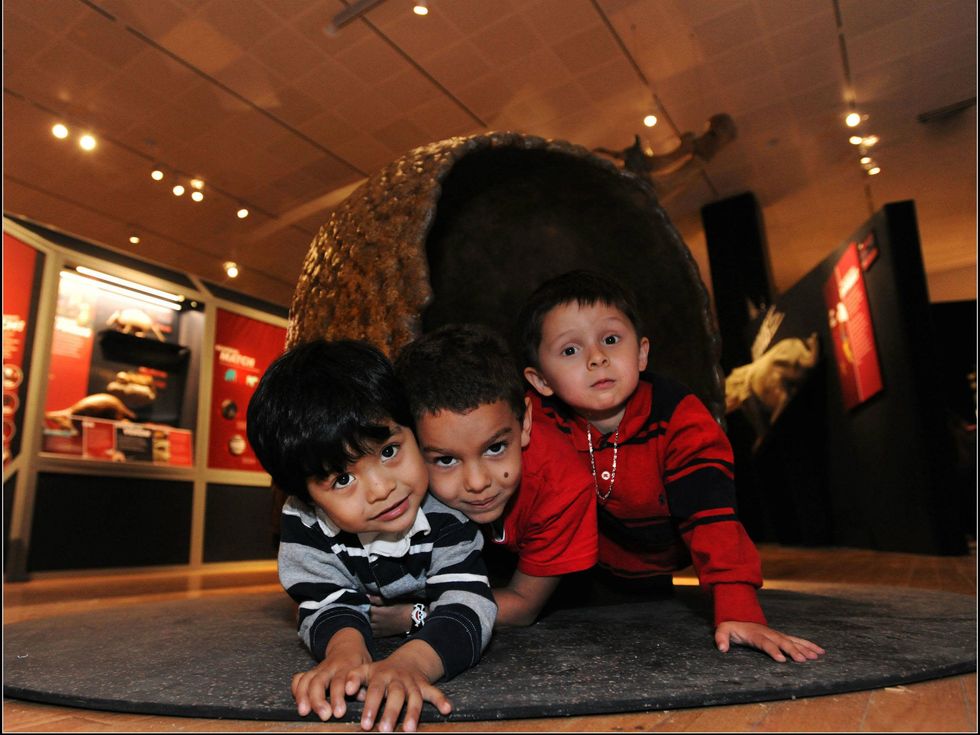Bullock Museum's Extreme Mammals
Extreme Mammals exhibit makes exclusive Texas stop at Austin's Bullock museum
In late October, 11 18-wheelers arrived at Bullock Texas State History Museum in Austin, packed with 120 Indiana Jones-style crates: large, wooden boxes marked “Fragile” and “This Side Up.”
“Extreme Mammals” has arrived for its only Texas stop. The exhibit showcases everything mammalian, from the largest one ever to walk the earth — 15-foot tall rhino relative Indricotherium (the average elephant stands only 8 to 12 feet high) — down to the smallest, Batodonaides. a shrew that measures one and a half inches long.
Throughout the exhibit are models and artifacts of mammal skeletons, horns and other head gear, teeth, brains, locomotion, defense and more.
This mismatched pair greets visitors as they step inside the museum’s Herzstein Hall. Throughout the exhibit are models and artifacts of mammal skeletons, horns and other head gear, teeth, brains, locomotion, defense and more — in short, every aspect of life as a warm-blooded, hairy animal that gives birth to live offspring and nurses that offspring. There will not be a test, but you’ll come out smarter nonetheless.
The exhibit, developed by the American Museum of Natural History in New York with collaboration from the California Academy of Sciences, Cleveland Museum of Natural History and Canadian Museum of Nature, features 91 different animals, 24 of them with a tie to Texas. Those include a horned gopher (specimens were found in South Texas); pronghorn, saber-toothed cats (specimens found near San Antonio); a nine-banded armadillo; a giant sloth whose relatives used to live in Texas and an extinct bat with relatives in Texas.
Nine employees of the Bullock museum and three from the American Museum of Natural History spent several weeks unpacking the crates and setting up the exhibit. They employed boxes of tools and stacks of hardware from nuts and bolts to pins and tape. Just the assembly of “Peggy,” as the Indircotherium model is affectionately known, required four people, said Toni Beldock, head of exhibits design and production at the Bullock.
Interactive touches include a large mirror that puts visitors' faces behind the teeth of a variety of animals, such as a capybara and saber-toothed tiger. “Do the Locomotion” lets the curious turn a dial to speed up or slow down various methods of mammal movement, from knuckle-walking to swimming and flying. Visitors may be surprised to learn that there was once a walking whale, a strange mammal that looked much like a large crocodile. They may also be impressed to see a 52 million-year-old bat.
Initial release of the exhibit coincided with discovery of Darwinius masillae, a small primate that filled in a missing link in human evolution, says Justin Steeve, installation manager from the AMNH. That discovery reinforced the AMNH's desire to showcase all the differences among mammals with this exhibit, he added.
Museum spokesperson Laura Hubbard says the Bullock wanted to do something unique, as well as an exhibit with a natural history angle. “Extreme Mammals” runs from November 23 through March of 2014.
The grand finale of Extreme Mammals, an elaborate diorama called “Swamps of the Arctic,” includes skeletons of a giant sloth and a dire wolf from the La Brea tar pits. While most of the species featured are long gone, the exhibit features a few brand-new ones, such as a striped rabbit recently discovered on sale in Asian food markets.
The museum offers a guide booklet for those who want to browse on their own, as well as guided tours offered at specific times or by arrangement. Count on at least two hours to do this extreme exhibit justice.





